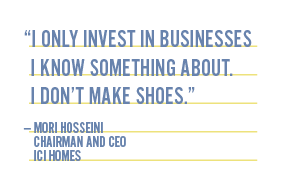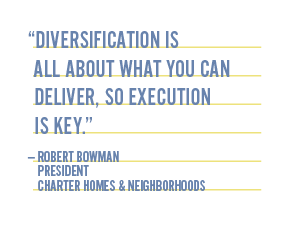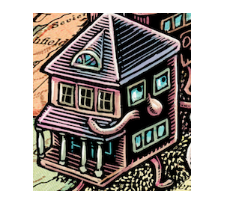In the late 1980s, Mori Hosseini, chairman and CEO of ICI Homes, in Florida, was increasingly alarmed by the pressure on his company and other midsize single-state home builders by larger production operations looking to stake claims in as many markets as possible through acquisitions. To remain viable, ICI Homes took a different course.
In short, the builder diversified: In 1987, it opened Allstar Building Materials, a lumber company in Ormond Beach, Fla., and in the ensuing years branched out to several other businesses, including Southern Title, based in Daytona Beach, Fla., which now has 10 locations; a trio of realty companies; and a division to manage rental properties in ICI’s communities. There’s also a group that develops property for other builders and sells land for apartments and retail.
ICI weathered the competitive maelstrom back then and today enjoys a thriving home building operation that closed 532 houses last year and is targeting 725 closings in 2019. Hosseini’s investment in ancillary businesses paid off, too, as they now collectively account for 29 percent of the corporation’s annual revenue. While Hosseini is their majority shareholder, they are self-sustaining entities, with no more than 10 percent of their sales revenue coming from ICI Homes’ construction activities.
ICI Homes is among the dozens of small-to-midsize home builders around the country that have expanded their portfolios to encompass a diverse mix of businesses, including residential and commercial remodeling, land development and sales, real estate brokerage, rental property management, and multifamily and commercial construction, to hedge against new-home downturns and competition from larger—usually national—production builders.
Why Are Home Builders Diversifying?
This diversification is almost always self-financed. And while some builders, such as ICI Homes, set up new businesses as independent entities with their own management teams and pro formas, other builders prefer to manage them like departments within their home building operations.
Even so, in all but a few cases, builders that diversify don’t stray too far from their cores. “I only invest in businesses I know something about,” Hosseini says. “I don’t make shoes.”
 Typically, builders diversify in response to tectonic shifts in competition or the economy that are eroding their sales or, more likely, profits. Even in places like Wisconsin, where national production builders are relatively scarce, diversification “is a hedge for market share,” says Matt Neumann, CEO of Neumann Companies, a Pewaukee, Wis.-based home builder since 1986 that has made a science of it (see “Filling the Frame,” below).
Typically, builders diversify in response to tectonic shifts in competition or the economy that are eroding their sales or, more likely, profits. Even in places like Wisconsin, where national production builders are relatively scarce, diversification “is a hedge for market share,” says Matt Neumann, CEO of Neumann Companies, a Pewaukee, Wis.-based home builder since 1986 that has made a science of it (see “Filling the Frame,” below).
Diversification has long been a survival tactic for builders. In February 1985, the Chicago Tribune ran an article with the Cassandra-like headline “Home Builders Find It’s Diversify or Die,” featuring single-family builders that had expanded into residential and commercial renovation.
NAHB has been nudging its members to diversify for decades; a course on diversification is part of the association’s curriculum for the Graduate Master Builder designation. In Houston, it’s a 5-hour class during which “we try to get builders to think about other related businesses, like commercial construction and land development, even handyman services,” says Ed Harrison, a course instructor and the owner of Harrison Homes, in Ovilla, Texas.
His company does land development, too, which Harrison believes should be run as a separate entity because of the debt and liability issues involved. On the other hand, he says, remodeling is less risky and therefore can more easily be folded into a builder’s existing operations.
Home Builders Seeking New Business Horizons
As often as not, a stalled economy is what motivates builders to look to new (and multiple) horizons. “We diversified purely out of necessity; we had to create jobs to keep our people working,” recalls Nelson Chung, president of Pacific Communities Builder, based in Newport Beach, Calif. During the years 2007 to 2009, price points for homes in the Inland Empire had dropped by between 25 percent and 40 percent. That’s when his company got into remodeling REO properties it had acquired for resale and rent.
Between 2008 and 2011, Pacific acquired somewhere between 100 and 150 foreclosed homes, and at one time had up to 350 rental properties, most of them located near Pacific’s communities, so they were relatively easy to manage. This maneuver, in retrospect, turned out to be more of a stopgap measure. As the housing market got back on track, Chung stopped buying foreclosed homes, and his rental properties have dropped below 100.
Pacific’s lot inventory, on the other hand, now tops 10,000 and the builder sells a percentage of its developed lots to other builders and developers. But Chung laments an unreliable revenue stream, lengthy due diligence, and fickle buyers for that model. He’d prefer to use more of his lots to build entry-level homes in the low $350,000s and support Pacific Communities’ goal of 270 closings this year.

Builders Branch Out to Apartments and Senior Living
Some builders actually diversified into new-home building. HHHunt, in Glen Allen, Va., started in 1966 building student housing for Virginia Tech University in Blacksburg, Va. That division has since grown into HHHunt Apartment Living, which has 25 communities in four states. Last year, it delivered three new communities, each averaging about 290 apartment units.
In the mid 1960s, HHHunt also launched a land development business in Richmond, Va., now called HHHunt Communities, which has developed more than 20,000 lots. And in the mid ’90s, HHHunt branched out again with a senior living division, called Spring Arbor Living, which currently has 23 communities in three states. Last year, that division delivered two new projects, each with about 100 units. More than half of HHHunt’s 2,700 employees work for that division.
The company entered single-family home building in the early 1990s almost by accident, says its president and COO Dan Schmitt. “One of our builders walked off a job and we suddenly found ourselves building houses.” Schmitt admits the transition was difficult at first, but his company eventually got the hang of it: Hunt closed 680 homes last year.
HHHunt’s organizational chart now shows one president running the apartment-living and senior-living divisions and separate presidents for the home building and communities divisions. Last year, the apartment-living division contributed 43 percent of HHHunt’s income, home building 26 percent, senior living 22 percent, and HHHunt Communities 9 percent.
Aside from leveraging some public money for apartments, HHHunt has provided all of the capital for its diversification. The company, which generated $542 million in housing revenue last year, as a policy reinvests 90 percent of its annual profits into its various divisions.
Those divisions used to vie for capital resources, but Schmitt didn’t like that model because it siloed each enterprise. So six years ago he switched to a capital allocation model, which provides flexibility so the company can shift funds based on market conditions and gives each business a better idea about what it has to work with. “It helps us manage our risk,” he says.
The Builders Group, in Tuscaloosa, Ala., closed 94 homes and rental units last year, 18 of which were multifamily. But it started in the early 2000s remodeling houses and managing rental properties. As of early February, the company had 35 rental units available, which company president Brock Corder says benefits the company’s new-home sales by providing transitional housing for buyers.
With that, The Builders Group expanded into commercial construction a decade ago, building wood- and steel-framed offices and warehouses. Corder observes that his commercial division doesn’t have the same relationship with subcontractors bidding for those jobs as his home building division does with subs he calls “our partners.” The trade-off: Profit margins are generally higher on commercial and remodeling projects.
The Builders Group’s ancillary businesses, which account for between 10 to 25 percent of the company’s total annual revenue, are folded into its home building operations. And now that home building is good, “we can be selective about the commercial or remodeling jobs we do,” Corder says.
Diversification as the Only Option for Builders
Skogman Homes already captures at least one-fifth of new-home sales in Cedar Rapids, Iowa, its corporate headquarters. So the company has two options for growth, says president and CEO Kyle Skogman: expand to other markets (which it tried in the past but pulled back from during the last recession) or diversify in its existing markets. It chose the latter.
Aside from building and selling single-family homes, closing 145 units last year, Skogman Homes builds duplexes, and earlier this year was building four 30-unit apartment buildings. The company also owns and manages 230 rental units.
A few years ago, it acquired a small remodeling/handyman firm that had been in business for 10 years. As for competing for jobs against local remodeling specialists, Skogman explains that the latter focus on projects in the $250,000 to $300,000 range. “There’s much less competition for the $100,000 to $200,000 jobs, which we’re going after.”
Skogman Homes’ diversification dates back 30 years to Skogman Realty, a brokerage with four offices employing 180 agents that the company continues to run as a profit center. The brokerage business “puts our [new] homes front and center” for sellers looking for a new place to live, Skogman says.

All told, Skogman Homes’ ancillary businesses account for as much as 60 percent of the company’s annual revenue. Its latest new venture is self-storage; the company recently started construction on a 100-unit facility located near its apartment buildings.
Self-storage is a profitable sideline for many builders, including HHHunt, which built two self-storage buildings last year and is in the zoning process for two more. Schmitt says they serve as amenities for its existing housing communities, on land that the company controls, and despite just six months of data, he expects an internal rate of return north of 20 percent.
Skogman is similarly optimistic, estimating that the return on his company’s investment in self-storage is potentially higher than anything else in the company’s portfolio and double that of its single-family housing division.
More Builders Tapping the Rental Market
Builders also are diversifying into single- and multifamily rental homes, either building new homes (and sometimes whole communities), renovating existing homes for rent, or managing property ... or a combination of those businesses.
The seven G. J. Gardner home building franchises in Colorado are engaged in a variety of such projects, including a 31-unit townhouse project currently in design and a just-completed 16-unit building, says Brook Swientisky, Gardner’s sub-franchisor for Colorado, Wyoming, and Kansas.
In East Lansing, Mich., Mayberry Homes is preparing to spin off its general contracting business, called MBH, to build multifamily rental units for local developers. “It’s our response to the sustaining shift toward apartment living,” says co-owner and president Robert Schroeder.

Mayberry has actually been active in that realm for about two years, though more recently focused on rental apartments and cottages, and Schroeder admits that the venture went through a learning curve of different cost structures, subs, schedules, and client expectations compared with single-family for-sale projects before it was comfortable with multifamily construction.
Schroeder says MBH will confine its construction to midrise stick-built or light-steel residential construction; it would also accept light commercial work, but nothing that entails structural steel or concrete.
For the past few years, Stylecraft Builders, in Texas, has operated a separate division, Leading Real Estate, which builds and manages single-family rentals. The company—which closed 745 homes last year—built about 35 houses specifically for rental, and Doug French, its CEO, expects that number to rise to between 40 and 50 this year, at which point French would like this division to have its own management and sales staff.
Unlike builders that rent what they can’t sell, Stylecraft’s approach has been to build homes specifically to be leased. In college towns such as Bryan and College Station, Stylecraft targets young families who, says French, “don’t want to be living near students and would prefer to live in a single-family home rather than an apartment.”
French concedes it’s a balancing act managing a for-sale and for-rent business simultaneously. “Stylecraft Homes pays the bills, so you want to make sure that the rentals aren’t getting preferential treatment” in terms of choice lots, he says. Stylecraft builds its rentals during slower times of the year to keep its trades and salespeople busy, though, French adds, he wants to aggressively grow the rental side of the business.
Execution Is Key in Any Builder Diversification Venture
EYA, based in Bethesda, Md., mostly builds single-family townhouses in the Washington, D.C., metro area, and closed 346 units in 2018. But in the past seven years, the company also built around 550 multifamily rentals and has another 1,000 apartments in its pipeline over the next five years.
Robert Youngentob, CEO and co-founder, says EYA is still working out the messaging for this part of its business, although he points out that multifamily rentals are typically marketed under the brand of their property managers.
EYA also has honed its land development skills around entitlement. “We’ve never bought an approved or finished lot,” Youngentob says. At any given moment, EYA will have between 300 and 350 lots under development for its own home building division as well as for other builders or developers.
The company has provided third-party development services for other developers as well. And for the past decade, it has worked with the local housing authority under a joint venture to build affordable and mixed-use housing. Youngentob explains that in this arrangement, EYA has been the developer, owner, and seller for market-rate homes, and the joint developer (with the housing authority) and general contractor for the affordable housing. EYA has also served as a consultant helping the housing authority secure tax credits.
Youngentob believes EYA’s various business interests dovetail, creating value for real estate, demand for market-rate housing, and fees that help support its home building efforts.

See THE 2019 HOUSING GIANTS LIST ranking the nation's largest builders
Charter Homes & Neighborhoods, in Lancaster, Pa., started branding its walkable communities in 2001. It registered its “The Great American Neighborhood” brand in 2013, and its 17 communities sold 323 homes last year. But Robert Bowman, the company’s president, recalls how Charter “fumbled its way through” neighborhood development and branding for the first 10 years. “What we learned along the way is that many builders do TNDs [Traditional Neighborhood Developments] as one-offs. We had to figure out how we could reproduce our neighborhoods consistently to include what everyone wants to be part of.”
The blueprint for Charter’s 60-to-100-acre neighborhoods sets aside 10 to 12 acres for around 250 rental apartments. Charter’s communities also make room for 1,000 to 1,500 linear feet of storefront for small, locally owned shops that Bowman says lend “authenticity” to his company’s neighborhoods. “Diversification is all about what you can deliver, so execution is key,” he says.
Charter recently started offering commercial retail and office design and construction to complement its communities. Bowman says Charter was able to find the design and construction talent within its organization, but had to go outside the company to find operations managers.
Mayberry Homes last year also started a community development division, which Schroeder says will make lots available this spring. He envisions about a half-dozen communities of between 600 and 700 acres, most of which Mayberry would control.
Last summer, Mayberry hired David Straub, a licensed Realtor and former division president at Toll Brothers, as its COO, and Keith Shaw as its first CFO. Schroeder says his company now needs a longer management bench in the event it decides to spin off any of its diversified businesses.
Diversification and Then ... The Next Move for Home Builders
Once some builders get a taste of diversity, they want more.
Schmitt says HHHunt is exploring ways for its various divisions to work together to develop walkable infill communities. The company also plans to expand into building and managing single-family rentals this year, and is “looking seriously” at developing multigenerational communities, as well as building senior-living facilities. If those plans work out and call for mixed-use construction, Schmitt says HHHunt would probably need to bring in a partner with that expertise.
As he looks toward the future, Hosseini foresees ICI Homes’ land development for commercial and apartment construction evolving into joint-venture partnerships with developers, or perhaps land leasing, all for the purposes of diversifying his company’s revenue streams.

Leveraging Diversification as a Growth Engine for Builders
Last September, Red Fox Crossing officially opened as Wisconsin’s first net-zero energy community. Located in the Milwaukee suburb of New Berlin, the 34-unit community is a portrait of vertical integration: Neumann Developments developed the home sites, Tim O’Brien Homes built single-family units ranging from 1,900 to 3,240 square feet, and Sunvest Solar designed and installed rooftop solar arrays, each generating six to eight kilowatts of power.
All of these businesses are part of Pewaukee, Wis.-based Neumann Companies, which leverages diversification as a growth engine. Founded in 1979 as a real estate seller, Neumann Companies got into home building in 1986 and launched Neumann Developments in 2000. Seven years later, Neumann Companies started Tim O’Brien Homes, which has become one of the industry’s leaders in green building and closed 189 homes last year, mostly semi-custom and custom products selling in the $400,000 to $800,000 price range.
In 2017, Neumann Companies forged a partnership with Cornerstone Development of S.E. WI to jointly create 40 to 50 Cornerstone-branded for-sale detached and attached condos per year. And last year it spun off Harbor Homes, a starter-home business with houses priced from $300,000 to $400,000.
That kind of diversity is still solidly in the home building realm, but launching Sunvest Solar in 2009 was a decidedly sideways move ... and a sign of the times. “The market for homes was terrible then,” says CEO Matt Neumann, who jokingly refers to the startup as a “mental distraction” to keep his employees’ minds off the recession.
That “distraction” has turned into a viable business that installs solar panels in seven (soon to be eight) states. About 5 percent of the homes constructed by builders under Neumann Companies’ umbrella include solar panels.
Neumann suggests parallels between solar and real estate. “It’s an asset that’s financed over 20 years.” Sunvest also offers leasing, which Neumann calls “power purchasing.” However, Sunvest’s focus lately is on commercial and community installations, where, says Neumann, the economics are better than for single-family residential.
See More of the 2019 Housing Giants Report
WHEELIN' AND DEALIN'—SIGNS OF A SLOWDOWN: Last year was a high-water mark for M&As among home builders, but experts say the industry is on the cusp of a slowdown
EASY DOES IT—CYCLE-TIME SOLUTIONS: How combining two or more phases of the construction process is helping builders achieve greater productivity and performance
THE LIST—2019 GIANTS RANKINGS: The largest builders, ranked
Access a PDF of these articles in Professional Builder's May 2019 digital edition
Rankings and articles about Housing Giants from previous years
Advertisement
Related Stories
Housing Giants
The 2024 Housing Giants Survey Is Now Open!
Complete the 2024 Housing Giants Survey to see if your company makes the cut in Pro Builder's rankings of the largest home building companies in the country
Housing Giants
Builder Rankings by Revenue: 2023 Housing Giants List
Pro Builder's annual Housing Giants rankings list provides a snapshot in time of builders’ perceived opportunities and challenges. These are the top 240 home builders in the nation, ranked by revenue
Housing Giants
Holding Back the Headwinds
Stormy market conditions strained the nation’s largest home builders in 2022, and they’re bracing for more uncertainty







